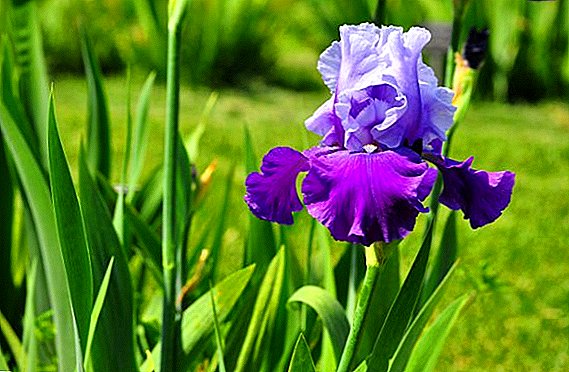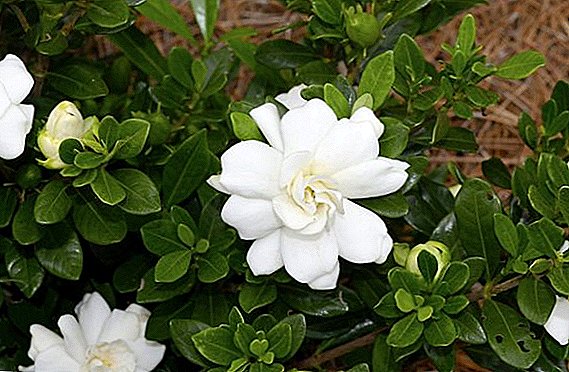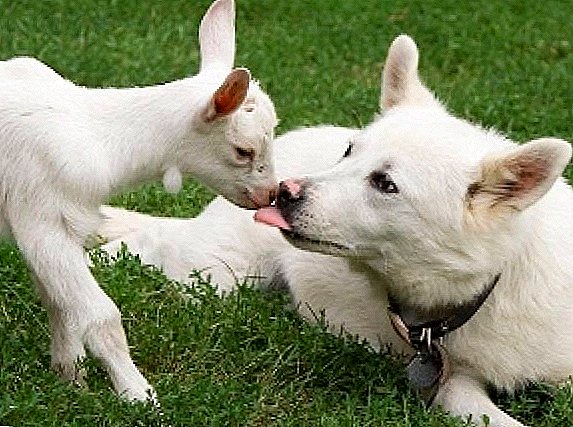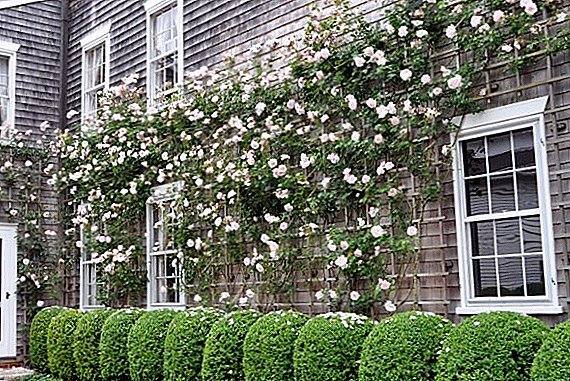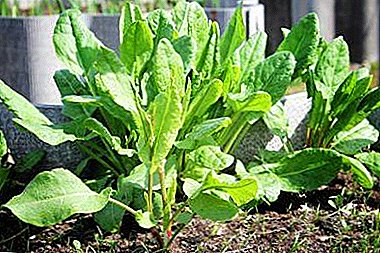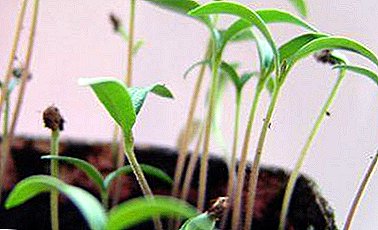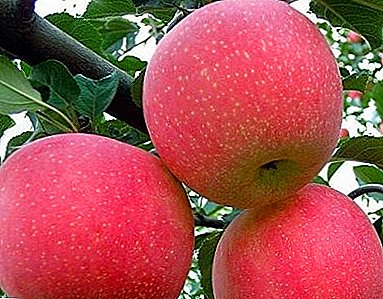
Today there are already a lot of varieties of apples, and one of the most famous and delicious Fuji is recognized in Russia and around the world.
Honey aroma, crispy white flesh, clean skin, medium-sized core - all this is worthy of the love of gardeners. The variety is mainly distributed in China, USA and Austria, although it was bred in faraway Japan. But for the last decades, Fuji has consistently conquered the markets of Russia and Ukraine.
What kind is it?
Fuji - winter apple variety, was created specifically for harvesting later in the year and storage in the cold.
Fruits of a grade can be stored at least until the end of spring, and even the next harvest. To preserve the appearance and taste of apples, they should be placed in a refrigerator or a cool cellar.
It is easy to store apples, they are suitable for long-distance transportation even in the winter season. But to get a good harvest, you need to know which varieties are suitable for pollination of Fuji.
Pollination of the apple tree
The tree is not self-pollinating, it needs other varieties. Excellent such as Gala, Grani Smith, Ligol, Golden, Everest, Red Delishes.
But Fuji itself is a diploid one, which means it can pollinate other apple trees.
The popularity of the variety was not created from scratch. And why did he, created in a country completely distant from Russia, receive recognition from us? And not only recognition, but also such epithets as "unusual" and "refined".
Description of Fuji
 The photo captures the Fuji apple tree, and below is a full description of the tree.
The photo captures the Fuji apple tree, and below is a full description of the tree.
The Fuji variety looks like a tall, strong tree, with a nice crown with strong branches.
By the end of autumn, they are strewn with dull, large apples with no dark spots or uneven color.
- The sapling becomes fastened with a tall tree with abundant fruiting in a periodic rhythm. To prevent this, a part of the ovary can be trimmed.
- The apple tree has a very strong ability to grow. 4-6 meters reaches easily under good conditions.
- The crown is formed quickly, easily, rather large, but somewhat erratic, as the branches grow in different directions. This can be corrected by the formation of the skeleton of the crown - then it turns out to be spherical or rounded-oval, fairly neat. By the end of autumn, Fuji is a bare branch with bright large fruits on them.
- Bark light brown, with a slight gray tint, not strongly wrinkled. Young shoots are brighter, smoother, have a small number of lentils.
- The leaves are lanceolate-oval or simply oval, with a pointed end. Pubescence can be seen only when the plate is growing. Flowering in average time, stalks are to escape at an acute angle.
The fruits are considered very attractive for the market.. We will see why.
- The correct form, smooth matte surface.
- Bright pink or red color that attracts attention.
- The flesh is white, cream color. Juicy, sweet or sour-sweet, crispy, with a pronounced aroma.
- The core is average, the chambers of the seeds are thin, light.
- Large weight (200-250 g).
Such a bright variety, distinguished favorably by both appearance and taste, was not easy to bring out. But until now, breeders base on it other, already future, new apple trees.
A photo


Breeding history
Grade received in Japan in 1920. Gardeners crossed varieties Red Delicious and Rolls Janet. For them it was important to create such an apple tree that it will easily survive both frosty winters and dry summer months.
The result is a sweet, fresh product that still attracts new fans from among both professionals and buyers. In the United States was brought only in the 80swhere he gained popularity. He began to consider exotic, unusual to his taste.
Breeders deduce other varieties similar to each other. At the same time gardeners seek to preserve the properties of the tree and the sweetness of the fruit.
The variety from Japan began to grow in all countries, having its own characteristics in different regions. Breeders have created clones that are popular both in Russia and in other countries.
Natural growth region
 Initially, the variety grew in Japan, but is now grown all over the world, even in fairly cold regions.
Initially, the variety grew in Japan, but is now grown all over the world, even in fairly cold regions.
Winter-resistant variety, suitable for central Russia, can hold fruits on the branches until the cold.
Even if there are no leaves left on the tree, the harvest is quite suitable for harvesting precisely in such a period. It is important to choose the right clone for cultivation - it will depend on the ripening period, the resistance of wood and fruits to external environmental factors.
Now there are several clones of apple. We (in the Krasnodar Territory) grow a red variety Fujik, in Italy - Kiku.
Although any plant is affected by the region where it grows, the overall yield can be derived. Moreover, Fuji breeders sought to make as fruitful as possible.
Yield
Grade Fuji gardeners will appreciate the high yield. Typically, the collection can begin in late October - early November, when it is already noticeably colder. The tree fructifies every second year in a light form, so that the crop is removed virtually every late autumn.
In order for the crop to be large, it is with the properties that were originally laid in the variety that one should remember about caring for the tree.
Planting and care
 Care is not very different from caring for other varieties of apple trees, there are only a few features associated with a particular selection.
Care is not very different from caring for other varieties of apple trees, there are only a few features associated with a particular selection.
- Planting Fuji is better on the south side, where the tree will have enough sun all the time. At the same time free air access is required.
- The soil should be enriched with nutrients and dressings, create a moderately moist environment.
- To get a good harvest, it is recommended to cut off part of the ovaries that take too much force from the apple tree. Then the tree will not be overloaded with fruits, the quality of the crop will increase, which means both taste and size.
- But care is not only in feeding and pruning the ovary. Fuji though resistant grade, but prone to their diseases.
Diseases and pests
Fuji, although resistant to cold, can be destroyed by bacteria and aphids. The first is dangerous because the tree can rarely be saved, only prevention helps.
- Powdery mildew and bacterial infections can harm the variety, so protection against such pests is particularly relevant. From the bacterial burn just save the sun rays, which is very fond of the tree. From drugs suitable those that contain copper.
- If the tree is already affected by bacteria, it will be safer to uproot it, because the infection will spread to other apples.
- Scab will cause less damage to the apple tree if the disease does not run. Young trees are especially prone to it. Prevention - Spraying with 1% Bordeaux liquid. If Fuji is already infected, use fungicides.
- In hot years, Fuji can inhabit the aphid causing serious harm. They begin to fight them in spring, using peritroids, in the summer - phospho-organic preparations.
- To protect the plant before planting, lower the root system in a 1% solution of copper sulfate for 3-4 minutes, then rinse with water.
 Trees need sanitary pruning, carried out regularly, watering and feeding.
Trees need sanitary pruning, carried out regularly, watering and feeding.
Generally, protection and spraying will save Fuji from losing fruit if done in advance with the help of special means. You can buy them in any garden stores.
Fuji is a great variety for a climate where hot summer days are not always possible. Apples have proven themselves in different countries due to their rich taste and aroma.
They are collected at the end of autumn, and you can keep it cool until the next harvest.. Persistence of fruit makes it easy to transport, so that apple lovers from different countries have already met Fuji.




